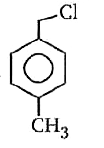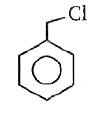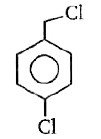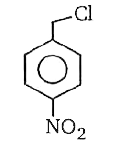The most reactive towards SN1 is:
PhCH2Cl
Ph−Cl
CH3CHCl(CH3)
p−NO2−Ph−CH2−Cl
The correct Answer is:A
To determine which compound is most reactive towards an SN1 reaction, we need to analyze the stability of the carbocations that would form from each option. The stability of the carbocation is crucial because the SN1 mechanism involves the formation of a carbocation intermediate. Here’s a step-by-step solution:
Step 1: Understand SN1 Mechanism
The SN1 (Substitution Nucleophilic Unimolecular) reaction involves two steps:
1. Formation of a carbocation.
2. Nucleophilic attack on the carbocation.
The rate of the reaction is determined by the stability of the carbocation formed.
Step 2: Identify the Carbocations
For each option provided, we will identify the carbocation that would form after the leaving group (usually a halide) departs.
1. Option 1: The structure has a phenyl group (pH) attached to a carbon with a chlorine (Cl). When Cl leaves, the carbocation formed is resonance-stabilized due to the phenyl group.
2. Option 2: The structure has a chlorine attached to a carbon that is not stabilized by resonance. The carbocation formed here is less stable compared to the first option.
3. Option 3: This is a haloalkyl compound without any resonance stabilization. The carbocation formed will be quite unstable.
4. Option 4: The structure has a chlorine attached to a carbon with a nitro group (NO2) at the para position. The nitro group is an electron-withdrawing group, which destabilizes the carbocation formed when Cl leaves.
Step 3: Analyze Carbocation Stability
- Resonance Stabilization: The carbocation from Option 1 is resonance-stabilized due to the phenyl group, making it the most stable.
- No Stabilization: Options 2 and 3 have no resonance stabilization, making them less stable.
- Destabilization: Option 4 has an electron-withdrawing group (NO2), which destabilizes the carbocation.
Step 4: Conclusion
Since the stability of the carbocation directly influences the reactivity towards the SN1 mechanism, the most stable carbocation is from Option 1, which is resonance-stabilized. Thus, the most reactive towards SN1 is:
Answer: Option 1
---
The SN1 (Substitution Nucleophilic Unimolecular) reaction involves two steps:
1. Formation of a carbocation.
2. Nucleophilic attack on the carbocation.
For each option provided, we will identify the carbocation that would form after the leaving group (usually a halide) departs.
2. Option 2: The structure has a chlorine attached to a carbon that is not stabilized by resonance. The carbocation formed here is less stable compared to the first option.
- Resonance Stabilization: The carbocation from Option 1 is resonance-stabilized due to the phenyl group, making it the most stable.
- No Stabilization: Options 2 and 3 have no resonance stabilization, making them less stable.
- Destabilization: Option 4 has an electron-withdrawing group (NO2), which destabilizes the carbocation.
Since the stability of the carbocation directly influences the reactivity towards the SN1 mechanism, the most stable carbocation is from Option 1, which is resonance-stabilized. Thus, the most reactive towards SN1 is:
Topper's Solved these Questions
- ELECTROCHEMISTRYBOOK - ALLENCHAPTER - ELECTROCHEMISTRYEXERCISE - MISCELLANEOUS SOLVED EXAMPLES
29 Videos
- ELECTROCHEMISTRYBOOK - ALLENCHAPTER - ELECTROCHEMISTRYEXERCISE - COMPREHENSION TYPE
18 Videos
- CHEMISTRY AT A GLANCEBOOK - ALLENCHAPTER - CHEMISTRY AT A GLANCEEXERCISE - ORGANIC CHEMISTRY
472 Videos
- HYDROCARBONBOOK - ALLENCHAPTER - HYDROCARBONEXERCISE - MCQ
15 Videos
Similar Questions
Knowledge Check
Which of the following is most reactive towardSN2 reaction ?
A B
B C
C D
D
Which of the following is most reactive towardSN2 reaction ?
ACH2=CH−CH2−ClBPh−CH2−ClC DPh−C∣∣O−CH2−Cl
DPh−C∣∣O−CH2−Cl
Which one is most reactive towards SN1 reactions ?
View SolutionWhich is most reactive towards Br2 in the prsence of FeBr3?
View SolutionArrange the following in decresing order of reactivity towards SN1 :-
(P) CH3−O−CH2−Cl (Q) CH3−NH−CH2−Cl
(R)
View SolutionMost reactive halide towards SN1 reactions is
View SolutionThe most reactive amine towards dilute hydrochloric acid is…
View SolutionThe most reactive amine towards dilute hydrochloric acid is
View Solution
